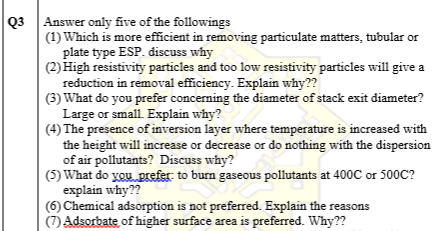Which is more efficient in removing particulate matters, tubular or plate type ESP. discuss why
Q3 Answer only five of the followings (1) Which is more efficient in removing particulate matters, tubular or plate type ESP. discuss why (2) High resistivity particles and too low resistivity particles will give a reduction in removal efficiency. Explain why?? (3) What do you prefer concerning the diameter of stack exit diameter? Large or small Explain why? (4) The presence of inversion layer where temperature is increased with the height will increase or decrease or do nothing with the dispersion of air pollutants? Discuss why? (5) What do you prefer to bum gaseous pollutants at 400C or 500C? explain why?? (6) Chemical adsorption is not preferred. Explain the reasons (7) Adsortate of higher surface area is preferred. Why??

Step by step
Solved in 3 steps









